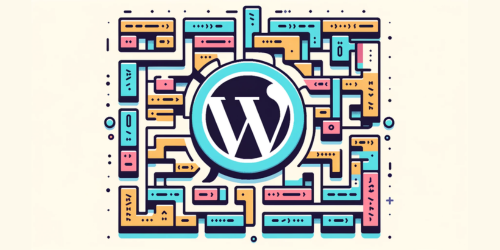Have you ever wondered how the digital world’s backbone, WordPress, continues to evolve? Since its inception in 2003, WordPress has emerged as a cornerstone in the website creation realm, frequently updating and expanding its capabilities.
Fast forward to 2023, and we welcome WordPress Version 6.4, the latest chapter in this ongoing saga of digital innovation. This release marks a significant leap from its predecessors, embedding new features and enhancements that redefine ease of use and functionality for millions of users globally. In this article, we’ll unfold the layers of WordPress 6.4, showcasing how it’s more than just an update—it’s a revolution in website management and design.
Key Take-Aways
- WordPress 6.4 is the latest version, with significant enhancements for website management and content creation.
- Emphasis on user-friendly features like the improved Site Editor, Lightbox effect, and vertical text orientation.
- Introduction of the new default theme, Twenty Twenty Four, showcasing advanced styling options.
- Notable improvements in performance, accessibility, and template loading.
1. Key Features of WordPress 6.4
WordPress 6.4 isn’t just another update; it’s a game-changer in the world of web design and content management. It introduces a suite of features that significantly streamline website creation and editing. The enhanced Site Editor is a standout, offering a more intuitive interface for site customization, including a redesigned Templates and Patterns menu.
Content creators will appreciate the new Lightbox effect for displaying images and the innovative vertical text orientation, adding an artistic flair to website layouts. These advancements are not just for aesthetics but are designed to make website management more efficient and user-friendly, ensuring WordPress remains at the forefront of web technology. For a detailed look into these features, visit WordPress News.
2. Managing Website Content with WordPress Version 6.4
WordPress 6.4 elevates content management to new heights. One of the most user-centric updates is the customization of attachment page settings. In previous versions, every uploaded image generated a separate attachment page, often cluttering search results and impacting SEO. WordPress 6.4 smartly disables this by default, significantly enhancing SEO performance.
Additionally, the version introduces improved pattern categorization, enabling webmasters to organize custom block patterns efficiently. These improvements not only streamline the backend experience but also reflect WordPress’s commitment to providing a more robust and SEO-friendly platform. Learn more about these content management enhancements at WordPress Documentation.
3. User Experience and Navigation Enhancements
WordPress 6.4 brings a fresh breeze to user experience and navigation. The update simplifies the website building process with user-friendly navigation enhancements. Among these, the introduction of the Twenty Twenty Four theme stands out. This theme, while maintaining the tradition of sleek design found in its predecessors, steps up with more styling options and presets, offering a live preview in the Site Editor.
This makes it easier for users, even those without coding skills, to customize their site’s appearance. The theme serves as a practical and aesthetically pleasing starting point for exploring the possibilities of WordPress 6.4. Explore the Free WordPress themes in detail at WordPress Themes.
4. Performance and Accessibility Updates in WordPress 6.4
WordPress 6.4 isn’t just about aesthetics and usability; it significantly boosts performance and accessibility. The update incorporates over 170 enhancements, focusing on speeding up page load times and optimizing backend processes. Notably, it introduces more efficient query handling and revamped admin notice functions, streamlining the WordPress experience for both users and developers.
Accessibility has received a major boost as well, with over 50 improvements, including revised labeling and navigation, making WordPress more inclusive and user-friendly. These updates reflect WordPress’s commitment to delivering a high-performance and accessible platform. Discover more about these performance improvements at WordPress Challenges.
5. Implications for WordPress Users and Developers
For WordPress users and developers, version 6.4 is a milestone. It not only enhances the overall website management experience but also opens up new avenues for development. For website owners, the upgrade means a more intuitive, efficient, and SEO-friendly platform.
Developers can leverage the new features and performance upgrades to build more dynamic and responsive websites. To maximize the benefits of WordPress 6.4, it’s recommended to familiarize oneself with the new features, experiment with the improved Site Editor, and stay updated with WordPress community resources. For more in-depth insights and best practices, visit WordPress Developer Responsibilities.
6. Frequently Asked Questions (FAQ)
Q: How do I know if I have the latest version of WordPress?
To check if you have the latest version of WordPress, log in to your WordPress dashboard. The current version number is typically displayed at the bottom right of the dashboard. Alternatively, you can visit the “Updates” section to see if a new version is available.
Q: How do I update my WordPress to the latest version?
To update WordPress, go to the “Dashboard” and select “Updates.” If a new version is available, you’ll see an option to update. Click ‘Update Now’ and the process will begin automatically.
Q: Is WordPress still popular in 2023?
Yes, WordPress remains highly popular in 2023. It continues to be the leading content management system due to its flexibility, user-friendly interface, and strong community support.
Q: What’s new in WordPress 6.3.2?
WordPress 6.3.2 primarily focused on bug fixes and security enhancements. It was a minor update following the major release of WordPress 6.3, aimed at improving the overall performance and security of the platform.



